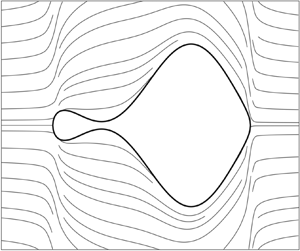Published online by Cambridge University Press: 14 July 2020

Resolving the detailed hydrodynamics of a slender body immersed in highly viscous Newtonian fluid has been the subject of extensive research, applicable to a broad range of biological and physical scenarios. In this work, we expand upon classical theories developed over the past fifty years, deriving an algebraically accurate slender-body theory that may be applied to a wide variety of body shapes, ranging from biologically inspired tapering flagella to highly oscillatory body geometries with only weak constraints, most significantly requiring that cross-sections be circular. Inspired by well known analytic results for the flow around a prolate ellipsoid, we pose an ansatz for the velocity field in terms of a regular integral of regularised Stokes-flow singularities with prescribed, spatially varying regularisation parameters. A detailed asymptotic analysis is presented, seeking a uniformly valid expansion of the ansatz integral, accurate at leading algebraic order in the geometry aspect ratio, to enforce no-slip boundary conditions and thus analytically justify the slender-body theory developed in this framework. The regularisation within the ansatz additionally affords significant computational simplicity for the subsequent slender-body theory, with no specialised quadrature or numerical techniques required to evaluate the regular integral. Furthermore, in the special case of slender bodies with a straight centreline in uniform flow, we derive a slender-body theory that is particularly straightforward via use of the analytic solution for a prolate ellipsoid. We evidence the validity of our simple theory with explicit numerical examples for a wide variety of slender bodies, and highlight a potential robustness of our methodology beyond its rigorously justified scope.